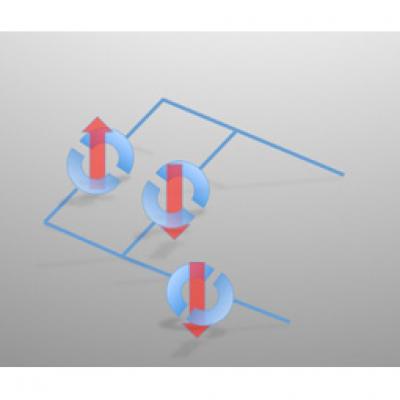Home > Press > Etch-a-sketch with superconductors: A breakthrough in controlling defects could lead to new generation of electronic devices
 |
| In future, X-ray beams could be used to write superconducting circuits, such as those depicted in the image. Here, solid lines indicate electrical connections while semicircles denote superconducting junctions, whose states are indicated by red arrows.
Credit: UCL Press Office |
Abstract:
Reporting in Nature Materials this week, researchers from the London Centre for Nanotechnology and the Physics Department of Sapienza University of Rome have discovered a technique to 'draw' superconducting shapes using an X-ray beam. This ability to create and control tiny superconducting structures has implications for a completely new generation of electronic devices.
Etch-a-sketch with superconductors: A breakthrough in controlling defects could lead to new generation of electronic devices
London, UK | Posted on August 22nd, 2011Superconductivity is a special state where a material conducts electricity with no resistance, meaning absolutely zero energy is wasted.
The research group has shown that they can manipulate regions of high temperature superconductivity, in a particular material which combines oxygen, copper and a heavier, 'rare earth' element called lanthanum. Illuminating with X-rays causes a small scale re-arrangement of the oxygen atoms in the material, resulting in high temperature superconductivity, of the type originally discovered for such materials 25 years ago by IBM scientists. The X-ray beam is then used like a pen to draw shapes in two dimensions.
A well as being able to write superconductors with dimensions much smaller than the width of a human hair, the group is able to erase those structures by applying heat treatments. They now have the tools to write and erase with high precision, using just a few simple steps and without the chemicals ordinarily used in device fabrication. This ability to re-arrange the underlying structure of a material has wider applications to similar compounds containing metal atoms and oxygen, ranging from fuel cells to catalysts.
Prof. Aeppli, Director of the London Centre for Nanotechnology and the UCL investigator on the project, said: "Our validation of a one-step, chemical-free technique to generate superconductors opens up exciting new possibilities for electronic devices, particularly in re-writing superconducting logic circuits. Of profound importance is the key to solving the notorious 'travelling salesman problem', which underlies many of the world's great computational challenges. We want to create computers on demand to solve this problem, with applications from genetics to logistics. A discovery like this means a paradigm shift in computing technology is one step closer."
Prof Bianconi, the leader of the team from Sapienza, added: "It is amazing that in a few simple steps, we can now add superconducting 'intelligence' directly to a material consisting mainly of the common elements copper and oxygen."
The X-ray experiments were performed at the Elettra (Trieste) synchrotron radiation facility. The work is published in Nature Materials, 21 August 2011 (doi:1038/nmat3088) and follows on from previous discovery of fractal-like structures in superconductors (doi:10.1038/nature09260).
####
For more information, please click here
Contacts:
Dave Weston
44-020-310-83844
Copyright © University College London
If you have a comment, please Contact us.Issuers of news releases, not 7th Wave, Inc. or Nanotechnology Now, are solely responsible for the accuracy of the content.
| Related News Press |
Superconductivity
News and information
![]() Researchers develop molecular qubits that communicate at telecom frequencies October 3rd, 2025
Researchers develop molecular qubits that communicate at telecom frequencies October 3rd, 2025
![]() Next-generation quantum communication October 3rd, 2025
Next-generation quantum communication October 3rd, 2025
![]() "Nanoreactor" cage uses visible light for catalytic and ultra-selective cross-cycloadditions October 3rd, 2025
"Nanoreactor" cage uses visible light for catalytic and ultra-selective cross-cycloadditions October 3rd, 2025
Chip Technology
![]() Lab to industry: InSe wafer-scale breakthrough for future electronics August 8th, 2025
Lab to industry: InSe wafer-scale breakthrough for future electronics August 8th, 2025
![]() A 1960s idea inspires NBI researchers to study hitherto inaccessible quantum states June 6th, 2025
A 1960s idea inspires NBI researchers to study hitherto inaccessible quantum states June 6th, 2025
![]() Programmable electron-induced color router array May 14th, 2025
Programmable electron-induced color router array May 14th, 2025
Discoveries
![]() Researchers develop molecular qubits that communicate at telecom frequencies October 3rd, 2025
Researchers develop molecular qubits that communicate at telecom frequencies October 3rd, 2025
![]() Next-generation quantum communication October 3rd, 2025
Next-generation quantum communication October 3rd, 2025
![]() "Nanoreactor" cage uses visible light for catalytic and ultra-selective cross-cycloadditions October 3rd, 2025
"Nanoreactor" cage uses visible light for catalytic and ultra-selective cross-cycloadditions October 3rd, 2025
Announcements
![]() Rice membrane extracts lithium from brines with greater speed, less waste October 3rd, 2025
Rice membrane extracts lithium from brines with greater speed, less waste October 3rd, 2025
![]() Researchers develop molecular qubits that communicate at telecom frequencies October 3rd, 2025
Researchers develop molecular qubits that communicate at telecom frequencies October 3rd, 2025
![]() Next-generation quantum communication October 3rd, 2025
Next-generation quantum communication October 3rd, 2025
![]() "Nanoreactor" cage uses visible light for catalytic and ultra-selective cross-cycloadditions October 3rd, 2025
"Nanoreactor" cage uses visible light for catalytic and ultra-selective cross-cycloadditions October 3rd, 2025
Research partnerships
![]() Lab to industry: InSe wafer-scale breakthrough for future electronics August 8th, 2025
Lab to industry: InSe wafer-scale breakthrough for future electronics August 8th, 2025
![]() HKU physicists uncover hidden order in the quantum world through deconfined quantum critical points April 25th, 2025
HKU physicists uncover hidden order in the quantum world through deconfined quantum critical points April 25th, 2025
|
|
||
|
|
||
| The latest news from around the world, FREE | ||
|
|
||
|
|
||
| Premium Products | ||
|
|
||
|
Only the news you want to read!
Learn More |
||
|
|
||
|
Full-service, expert consulting
Learn More |
||
|
|
||








